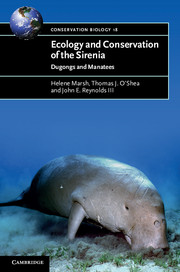Book contents
- Frontmatter
- Contents
- Foreword
- Preface
- Acknowledgements
- 1 Introduction
- 2 Steller’s sea cow
- 3 Affinities, origins and diversity of the Sirenia through time
- 4 Feeding biology
- 5 Behaviour and habitat use
- 6 Life history, reproductive biology and population dynamics
- 7 Threats
- 8 Conservation status
- 9 Conservation opportunities
- References
- List of online supplementary material
- Index
- Plate section
5 - Behaviour and habitat use
Published online by Cambridge University Press: 05 January 2012
- Frontmatter
- Contents
- Foreword
- Preface
- Acknowledgements
- 1 Introduction
- 2 Steller’s sea cow
- 3 Affinities, origins and diversity of the Sirenia through time
- 4 Feeding biology
- 5 Behaviour and habitat use
- 6 Life history, reproductive biology and population dynamics
- 7 Threats
- 8 Conservation status
- 9 Conservation opportunities
- References
- List of online supplementary material
- Index
- Plate section
Summary
Introduction
Knowledge of the behavioural ecology and habitat use of sirenians is critical for their conservation and management. In this chapter we summarise what is known about how sirenians perceive their environments; their swimming and diving behaviours; their activity and time budgets; their movements and migrations; and their anti-predator behaviour. These individual behaviours are clearly critical to understanding issues pertinent to the management of manatees and dugongs. Use of tactile senses to satisfy curiosity, for example, may explain their proclivity for entanglement and injury in lines and rope. Time spent at the surface can influence the susceptibility of dugongs and manatees to predators from below or to boat strikes or hunters from above. Activity and time budgets show the strong influence of seasonality on susceptibility to cold stress at the latitudinal margins of their distribution and to hunting during dry seasons in seasonally flooded environments. The scale of migrations and movements that sirenians employ can be highly informative for planning of reserves and protection of habitat corridors.
We also review knowledge of the social behaviour of sirenians, information that is fundamental for conservation. Do they occur in stable social groups that must have their integrity maintained? Are territories required for successful breeding? What factors may limit the potential diversity of sirenian mating systems? How do they communicate? Are patterns in the use of space transmitted through generations? How are young cared for and protected?
- Type
- Chapter
- Information
- Ecology and Conservation of the SireniaDugongs and Manatees, pp. 145 - 208Publisher: Cambridge University PressPrint publication year: 2011
- 2
- Cited by

